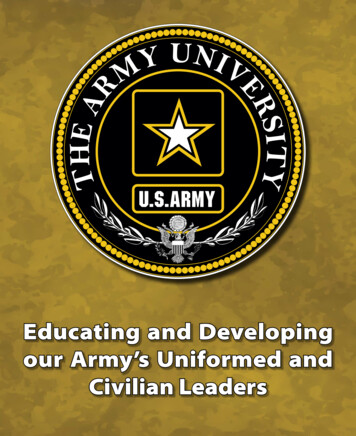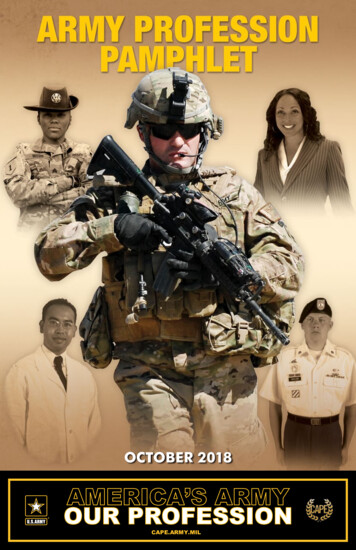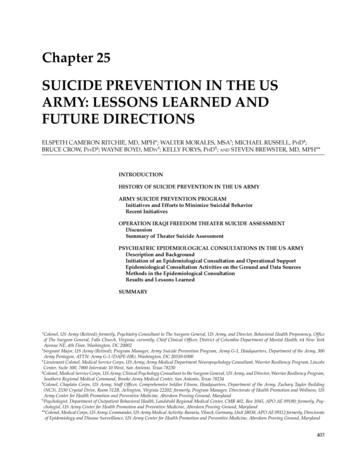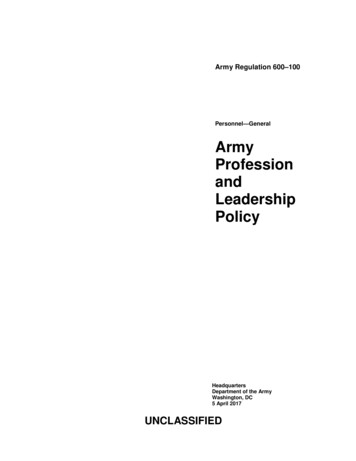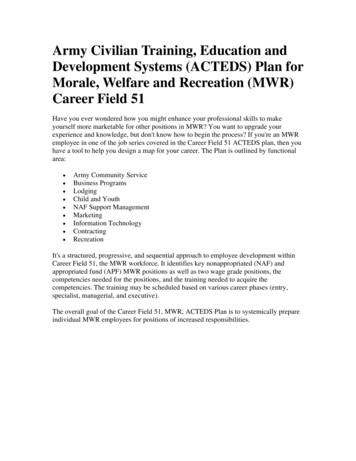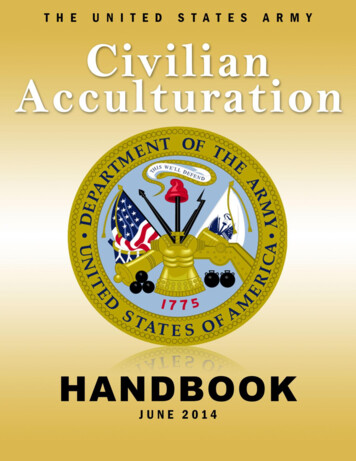
Transcription
1
FORWARD. 5CHAPTER 1: THE ARMY CIVILIAN CORPS . 6THE HERITAGE OF THE ARMY CIVILIAN CORPS .6THE CIVILIAN CREED .9OATH OF OFFICE .9SENIOR EXECUTIVE SERVICE .10CHAPTER 2: THE ARMY PROFESSION . 12WHAT DOES IT MEAN TO BE A PROFESSION? .12THE US ARMY AS A PROFESSION .12TWO COMMUNITIES OF PRACTICE .13THE 5 ESSENTIAL CHARACTERISTICS OF THE ARMY PROFESSION: TRUST, MILITARY EXPERTISE, HONORABLESERVICE, ESPRIT DE CORPS, AND STEWARDSHIP .14PROFESSIONAL CERTIFICATION PROCESS .19ARMY PROFESSIONALS AND THE NATION .20THE PROFESSION OF ARMS .21CHAPTER 3: THINGS EVERY ARMY CIVILIAN NEEDS TO KNOW . 22COMMON ACCESS CARD (CAC) .22PERSONALLY IDENTIFIABLE INFORMATION (PII) .24OPERATIONS SECURITY (OPSEC) .24GOVERNMENT COMPUTER USE .25GOVERNMENT TELEPONE USE .26GOVERNMENT TRAVEL CHARGE CARD (GTCC) .26MERIT SYSTEM PRINCIPLES .27PROHIBITED PERSONNEL PRACTICES .28CHAPTER 4: THE ORGANIZATION OF THE ARMY. 29THE COMPONENTS OF THE ARMY .29US ARMY STRUCTURE .30KEY LEADERS .34CHAPTER 5: CUSTOMS, COURTESIES, AND TRADITIONS . 35NATIONAL TRADITIONS AND OBSERVANCES .35US ARMY TRADITIONS AND OBSERVANCES .36CHAPTER 6: DIVERSITY AND LEADERSHIP . 44RESPONSIBILITY .44ARMY DIVERSITY PROGRAM .442
EQUAL EMPLOYMENT OPPORTUNITY (EEO) PROGRAM .44THE EEO COMPLAINTS PROCESS .46CHAPTER 7: READY AND RESILIENT . 48BUILDING STRENGTH – MAXIMIZING PERFORMANCE – READY AND RESILIENT .48RESOURCES .50CHAPTER 8: CIVILIAN HUMAN RESOURCES . 51NOTIFICATION OF PERSONNEL ACTION (NPA) .51WORK SCHEDULES AND WORKING CONDITIONS .51HOLIDAYS .54PAY .54PREMIUM PAY .54SALARY INCREASES .56LEAVE ENTITLEMENTS .57SERVICE CREDIT FOR LEAVE RATE ACCRUAL AND RETIREMENT FOR VETERANS .58VERIFICATION OF EMPLOYMENT .64APPROPRIATED FUNDS POSITIONS .64BENEFITS AND ENTITLEMENTS .65NEW EMPLOYEE BENEFIT ENROLLMENT OVERVIEW .66FEDERAL EMPLOYEES COMPENSATION ACT (FECA) .77PERFORMANCE MANAGEMENT .77LABOR-MANAGEMENT RELATIONS .78CHAPTER 9: CIVILIAN TRAINING AND LEADER DEVELOPMENT . 80TRAINING.80MANDATORY SUPERVISOR TRAINING .81ARMY LEADER DEVELOPMENT PROGRAMS .81CIVILIAN EDUCATION SYSTEM (CES) .81COMPETIVE PROFESSIONAL DEVELOPMENT PROGRAMS.82ACADEMIC DEGREE TRAINING (ADT) PROGRAM .83SENIOR ENTERPRISE TALENT MANAGEMENT (SETM) PROGRAM .83COMMAND AND CAREER PROGRAM SPONSORED LEADER DEVELOPMENT PROGRAMS .84DEPARTMENT OF DEFENSE LEADER DEVELOPMENT PROGRAMS .84IN SUMMARY.84CHAPTER 10: CAREER MANAGEMENT . 85THE 31 ARMY CAREER PROGRAMS .863
CHAPTER 11: INFORMATIONAL RESOURCES . 98INDEX OF HELPFUL WEBSITES .98COMMONLY USED ACRONYMS .1024
FORWARDWELCOME TO THE ARMY CIVILIAN CORPSCongratulations! I am excited to have you on the Army team. As a member of the ArmyProfession, you are important to the Army and its mission. This handbook will help yourtransition into the Army Civilian Corps. It acquaints you with the organization, expectations,traditions and culture of the Federal Civil Service and the United States Army and is a referencetool to have at your fingertips.Since 1775, Army Civilians have been indispensable members of the Army Profession. Youprovide expertise, continuity, stability, and leadership in every major Army organization. ArmyCivilians are committed to the Army mission: to shape, fight, and win our wars. Army Civilianshave assumed increased levels of responsibility and greater authority. During periods ofconflict, some Army Civilians volunteer to deploy to war zones, often assuming risks similar toSoldiers in combat sustainment roles. The Army Civilian Corps consists of approximately 23%of the total Army or about 300,000, individuals serving in more than 500 occupational fieldsspanning 31 career programs in organizations around the world.Army Civilians take a similar Oath of Office as Army Officers and members of Congress,solemnly pledging to support and defend the Constitution of the United States. Army Civiliansare expected to perform their duties to the same standard of ethical conduct as Soldiers embodied in the Army Civilian Creed, Army Values, and the Code of Ethics for GovernmentService. Regardless of your position, it is a privilege to be an Army Civilian, providing honorableservice to the Nation.We are proud to have you as part of the Army team and a member of the Army Civilian Corps.As an Army Civilian, I charge you to demonstrate technical competence, character, andcommitment in everything you say and do. Thank you for your service as you begin this newand exciting chapter as an Army professional.Hon. DEBRA S. WADAAssistant Secretary of the Army(Manpower & Reserve Affairs)5
CHAPTER 1: THE ARMY CIVILIAN CORPSThe Army Civilian Corps was established on June 19, 2006, by the Honorable Francis J. Harvey,former Secretary of the Army and General Peter J. Schoomaker, former Chief of Staff of theArmy. The Army Civilian Corps embodies the commitment of dedicated individuals who serveas an integral part of our Army team. Army Civilians have a 230-year record of service and are acritical component of the Total Army Force Structure.The Army Civilian Corps consists of experienced civilian personnel committed to serving theNation. Army Civilians fill positions on Army staffs and sustain base operations that wouldotherwise have to be filled by military personnel. They provide mission-essential capability,stability and continuity during war and peace in support of the Nation. It’s a mission that ArmyCivilians take personally.Go to this website to watch an inspiring video about the Army Civilians Corps:http://cape.army.mil/civilians.php.THE HERITAGE OF THE ARMY CIVILIAN CORPSCivilians have been working alongside Soldiers since the Revolutionary War when they werehired as skilled tradesmen, laborers and transportation workers or served as teamsters to movesupplies, artillery, and weapons. Normally, they filled jobs that were non-military in nature.Wherever the Army has Soldiers, odds are Army Civilians are there too. Without them, theArmy would be required to assign Soldiers to perform various support functions. Civilians evendeploy with military units during times of national emergency. Their history of loyal supportand service is remarkable. The Army Civilian of yesterday, today, and tomorrow, is and remainsan integral member of the Army team, one of four separate but vitally linked components or, asArmy terms them, cohorts. These cohorts are: Commissioned Officers, Warrant Officers,Noncommissioned Officers (NCOs) and Civilians.During World War I (WWI) and World War II (WWII), Army Civilians made significantcontributions. Though documentation is sparse leading up to WWI, during WWI,Quartermaster Corps reports showed civilian employment increased by more than 300% afterthe outbreak of the war. Similarly, while the Ordnance Corps reported having 96 Civilians onboard prior to the war, that number grew to 1,600 Army Civilians by 1917. Again, theSoldier/Civilian teamwork prevailed, especially during wartime. Incidentally, early in the war,the Army introduced a “personnel classification” scheme, the first of its kind that attempted tomatch the capabilities of its individual members with appropriate civilian jobs.Army civilian strength steadily rose during WWII from 137,000 in the prewar year of 1940 to1,188,000 in 1945. Those Civilians served with distinction in research and development,intelligence, logistics, communications, and medicine, as well as many other areas.6
In 1948, the Secretary of the Army’s annual report recognized the importance of Army Civilians.The report stated:“In every phase of its operations, the Army is dependent to a great extentupon the support of its corps of civilian workers. From manufacturing to thehighest levels of policy-making, these men and women – ‘Soldiers withoutuniform’ – are engaged in fundamental tasks of the Army.“The report further expressed concerns over the difficulty of obtaining qualified and loyalpersonnel to perform the diverse tasks required to support the Army.After WWII, the Army built a strong, highly regarded, civilian personnel management programin the federal government. As the corps of civilian workers grew, the need for progressive andsequential leadership training escalated. The first two civilian career programs, CivilianPersonnel Administration and Comptroller, were established in 1959. The Army was a federalservice pioneer in creating a structured career management system, and subsequent programsserved as forerunners for Defense-wide programs and information sources for other federalagencies.By the 1970s, the Army’s historical records made a positive shift in giving increased attention toArmy Civilians. The Army’s annual historical summaries generally focused on administrativeand personnel management data such as personnel strength, new personnel policies andprograms, civilianization of military positions, high grade controls, etc. Starting in 1976,however, statements on the importance of Army Civilians began to appear.In 1991, civilian manpower strength was at 435,195 (23 percent of the total force) with over3,000 Army Civilians deployed to Southwest Asia in support of Operation Desert Shield/Storm.Deployed Civilians maintained and repaired Army equipment on the ground. Hundreds of otherArmy Civilians performed myriad duties in support of the Gulf War such as acquiring,transporting, and maintaining supplies, combat material and spare parts to providing experttechnical assistance on weapons and equipment operation. Army Civilians ultimately proved tobe an integral part of the largest logistical support operation undertaken by United States Forcessince WWII, and ensured success beyond initial expectations.In recent times, Army Civilians have participated in many deployments – Bosnia, Hungary,Macedonia, Kosovo, Kuwait, Iraq and Afghanistan – in support of the Nation’s defensecommitments. While deployed, they performed: equipment maintenance; engineering;auditing; morale, welfare, and recreation activities; safety, human resources and personnelmanagement; and other sustainment related functions. From applying armor kits to Armywheeled vehicles, to installing electronic devices and tracking systems for logistical vehicles, toissuing new individual equipment to Soldiers, the continuing operations in Afghanistan and Iraqcould not be sustained without the support of Army Civilians and contractors. The message isclear - the Army is committed to doing all it can to support the deployed Soldier, and ArmyCivilians are doing all they can to meet that commitment.Army Civilians have deployed in support of military operations on many occasions throughouthistory but never to the degree that it has recently. With the drawdown of our military force in7
recent years, the role of Army Civilians has become increasingly critical to our ability tosuccessfully accomplish our missions. It has become necessary to develop ways to do more withless, and the traditional image of Army Civilians as strictly support personnel located at the rearof ongoing military operations is continually changing. As the size of the uniformed Army hasdecreased, many of the former Soldier positions in the policy, acquisition, force design, forcegeneration, and force sustainment have transitioned into Army Civilian Corps positions. ArmyCivilians, as well as civilian contractor personnel, are being deployed with our Soldiers inmilitary, humanitarian and restoration efforts.On January 23, 2009 the Defense Department established a Department of Defense (DoD)Civilian Expeditionary Workforce to ensure that American Civilians are equipped to deployoverseas in support of the worldwide military missions. The intent of the program is tomaximize the use of civilian workforce to allow military personnel to be fully utilized foroperational requirements. The signing of the DoD Directive 1404.10 states that selected Civilianemployees of the DoD will be asked to sign agreements stating that they will voluntarily deployin support of military missions for up to two years.Civilian employees deployed worldwide continue to provide critical technical, logistical, andmaintenance support to military units. Many of these Civilians have equipment, supply,telecommunications, and quality assurance specialties. Besides these functions, Civilians fillother very important roles in forward support of our military troops. Some of those areas ofsupport include intelligence gathering, realty services, physical security, contract management,automation support and engineering. Army Civilians are also being deployed in support ofmorale and welfare programs that provide recreational activities, sports, and continuingeducation opportunities for our deployed Soldiers.As the Army becomes smaller and more dependent on technology, dedicated Civilians supportAmerica's Army superbly -- at home, with overseas forces, and in contingency operations acrossthe globe. Army Civilians possess skills that are critical to the Army's success and make vitalcontributions to the Nation's defense. They are irreplaceable members of the Army team. ArmyCivilians continue to write a proud and lasting legacy in support of our Nation’s defense.The formal establishment of the Army Civilian Corps offered new avenues for thetransformation, identification and integration of our Army Civilians as full partners with ArmySoldiers. The Army Civilian Corps is supported by an Army Civilian Corps Creed. The CivilianCorps Creed is defined as a brief authoritative, doctrinal formulation of the principles, rules,opinions and precepts formally expressed and seriously added to and maintained. The CivilianCorps Creed reflects the war fighting spirit, commitment and ethos of our Civilian Soldiers toour Army and our Nation. It also helps to provide a level of purpose for the Army CivilianCorps.8
THE CIVILIAN CREEDJust like their counterparts in uniform, Army Civilians arecommitted to selfless service in the performance oftheir duties as illustrated in the Army CivilianCorps Creed.OATH OF OFFICEArticle VI of the United States Constitution stipulates, “The senators and representatives andthe members of the several state legislatures, and all executive and judicial officers, both of theUnited States and of the several states, shall be bound by oath or affirmation, to support thisConstitution ”Becoming an employee of the federal government, within any of the civilian employmentsystems, brings with it special responsibilities. Civilian employees are part of the executivebranch of the federal government and work for the American people. Their loyalty to thegovernment is a fundamental requirement of federal employment. Federal employees also havean obligation to the public, as they are often entrusted with work that is financed by taxpayers’dollars. Swearing or affirming an oath of office demonstrates a clear understanding of thatsense of loyalty, as well as an acceptance of the trust bestowed by the public.They are identical for congressional persons and United States Civilians, with only slightdifferences for US military officers and enlisted Soldiers. Accepting this oath is a serious9
matter; it demands that all appointees fully recognize they are undertaking a solemn obligationand pledge their utmost loyalty to the United States. The oath is legally binding – violationscan serve as a basis for criminal prosecution.The oath may only be administered by United States citizens who are specifically delegated thisauthority.CONGRESSIONAL AND CIVILIAN OATH OF OFFICE“I, , do solemnly swear (or affirm) that I will support and defend theConstitution of the United States against all enemies, foreign and domestic; that Iwill bear true faith and allegiance to the same; that I take this obligation freely,without any mental reservation or purpose of evasion; and that I will well andfaithfully discharge the duties of the office on which I am about to enter. So helpme God.”SENIOR EXECUTIVE SERVICEThe only Army Civilian Corps category that has an established insigniais that of theSenior Executive Service (SES). The SES was created by the Civil Service Reform Act of 1978.Congress designed the SES to be an elite corps of managers charged with running the FederalGovernment. The SES was set up as a separate, gradeless personnel system – distinct from thecompetitive and excepted services whose positions are classified above the GS-15 level of the GS.An executive may enter the SES as a career appointee, noncareer appointee, or limited termappointee. Careerists make up the great majority of the Army’s SES. Noncareer executivesserve at the discretion of the appointing authority. In the Army, senior executives are thecounterparts of general officers. To find out more information about SES The SES positions are sorted into three tiers based upon the position characteristics. Thehierarchy resembles the General/Flag Officer. Tier 1 – Equivalent to a 1 Star General. These positions generally involve intraComponent/agency participants. The latitude and responsibility, as indicated by thedegree of policy and decision-making authority, typically include Component/agencylevel only. Tier 2 – Equivalent to a 2 Star General. These positions generally involve multiComponent or intra-Component/agency participants. The latitude and responsibility,as indicated by degree of policy and decision-making authority, typically includeComponent/agency-level only. Tier 3 – Equivalent to a 3 Star General. These positions are complex and multi10
Component, multi-function, multi-national or joint interactions. They have the mostsignificant levels of latitude and responsibility, as indicated by degree of policy anddecision-making authority. The impact is extraordinary, tangible and substantiallyfurthers Department, Component and/or agency objectives and strategic goals.11
CHAPTER 2: THE ARMY PROFESSIONThis chapter discusses the Army Profession. It is important to understand the Army Professionas you continue your journey of becoming a certified Army professional. The Army has a dualnature—it is a military department of the United States Armed Forces and a military profession.As one of the Nation’s armed services, it carries out the missions assigned by the President ofthe United States, as the Commander in Chief, in accordance with the law and the intent ofCongress. As a unique military profession, the Army is built upon an ethos of Trust, whichbuttresses four other essential characteristics of the Army Profession: Military Expertise,Honorable Service, Esprit de Corps, and Stewardship.WHAT DOES IT MEAN TO BE A PROFESSION?A profession is a trusted, self-policing, and relatively autonomous vocation whose membersdevelop and apply expert knowledge as human expertise to render an essential service to societyin a particular field. Typically, a profession has five aspects:1. Professions provide a unique and vital service to the society served. One it cannotprovide itself.2. Professions provide this service by applying expert knowledge and practice.3. Professions earn the trust of the society because of effective and ethical application oftheir expertise.4. Professions self-regulate; they police the practice of their members to ensure it iseffective and ethical. This includes the responsibility for educating and certifyingprofessionals.5. Professions are therefore granted significant autonomy and discretion in their practice ofexpertise on behalf of the society.THE US ARMY AS A PROFESSIONThe Army is a trusted profession because of the expert work it produces, because the membersof the Army develop themselves to be professionals, and because the Army certifies them asprofessionals. The American people trusts the Army to perform the missions assigned to it inaccordance with The Constitution of the United States. The Army Profession plays a vital role asa member in the joint community and other government services that dedicate themselves toserving the United States. Army professionals pursue a noble calling and render honorableservice. They are privileged to provide for the common defense of the American people, operateto prevent conflict, shape operational environments, and win the Nation’s wars.12
The Army Profession: A unique vocation of experts certified in the design, generation,support, and ethical application of landpower, serving under civilian authority and entrusted todefend the Constitution and the rights and interests of the American people.Army Professional: A member of the Army Profession who exemplies the Army’sprofessional criteria in the areas of competence, character, and commitment.The professional responsibilities of Soldiers and Army Civilians include: Preserve the trust and confidence of the American people and fellow Army professionalsby sustaining the five essential characteristics of the profession (Trust, MilitaryExpertise, Honorable Service, Esprit de Corps, and Stewardship). Advance our expert knowledge, skills, and abilities in unified land operations, developevery Army professional in competence, character, and commitment. Strengthen our honorable service and demonstrate our strength of character by living inaccordance with the Army Values and the Army Ethic. These values and principles arethe basic moral building blocks of our profession. Army professionals are individuallyresponsible for developing and maintaining moral character and competence, on and offduty, while following their own personal commitment to work that is more than a job —a calling to serve in the defense of the Nation. Create and sustain a positive working environment, increase collaboration and teamworkto build cohesion, and foster pride in our profession’s winning spirit through esprit decorps. Through stewardship, ensure the present and future development and effectiveness ofthe profession’s people and resources. As stewards of this honorable profession, allArmy professionals must not only police themselves but also
Army. The Army Civilian Corps embodies the commitment of dedicated individuals who serve as an integral part of our Army team. Army Civilians have a 230-year record of service and are a critical component of the Total Army Force Structure. The Army Civilian Corps consists of experienced civilian personnel committed to serving the Nation.
